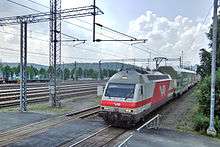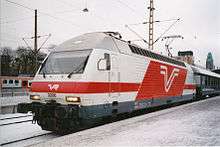VR Class Sr2
|
A Sr2 locomotive at Tampere railway station, June 2012 | |||||||||||||||||
| |||||||||||||||||
| |||||||||||||||||
| |||||||||||||||||
| |||||||||||||||||
The Sr2 is a class of electric locomotives of the VR Group. They were built by SLM / ABB and later by Adtranz and finally Bombardier Transportation and assembled by Transtech Oy.[1][2] They are closely based on the class Re 460 (or Lok 2000) locomotives of Swiss Federal Railways.
The nicknames of this class are Alppiruusu (Edelweiss), Käkikello (Cuckoo clock), both referring to the Swiss origin of the locomotive,[3] and Marsu (Guinea pig), from the looks of the locomotive.
History

In 1992, VR ordered the first 20 class Sr2 locomotives;[1] later 20 more were ordered with 12 options. Finally only six of the 12 options were transformed into orders, forming a total fleet of 46 engines.[3] The locomotives are used on both passenger trains and freight trains, and they are the primary locomotives of the fast InterCity trains in Finland.
Until mid-2010's Sr2's were pulling IC trains the classic way, but after Edo-class steering cars were introduced in 2013,[4] Sr2 units have been used in pull-push mode with IC double deck stock. Until introduction of new Sr3 locomotives, Sr2 has been the only electric locomotive equipped for push-pull among Finnish rolling stock.
Technical information
When introduced, the Sr2 was the strongest and fastest locomotive of the VR. It was designed with a top speed of 230 km/h (140 mph)[1] and early units had that speed marked on them.[5][6] During test runs, it has achieved a speed of 232 km/h (144 mph). However, VR later limited the top speed to 210 km/h (130 mph),[3] since test runs require 10% faster speed than the targeted commercial speed.
The locomotive has GTO-thyristor inverters driving three-phase asynchronous AC motors.[7] The maximum power of each air-cooled motor is 1,560 kW (2,090 hp) at 2600 V.[7] Combined, they are capable of a power output of 6,100 kilowatts (8,200 hp) (5,000 kW (6,700 hp) continuous power).[8] The motors are small and fit entirely within the bogies.[7] The bogies weigh only 15.8 tonnes and are equipped with radially steered axles.[1] This reduces rail wear significantly. A redesigned bogie construction was refitted by the manufacturer in the mid-2000s after the locomotives were found to oscillate sideways when running at speeds of over 160 km/h (99 mph).[9]
The whole construction of the locomotive is modular and all functions are controlled by several microprocessors via the locomotive bus (MICAS S2).[7] The system is redundant, so that a failure in one processor does not harm the overall system.[7] The data lines are fiber optic cables.[7]
Sr2 units are fitted with Unilink couplers, which combine a SA3 and a traditional chain coupler.[10]
Design and livery

Like for all the Lok 2000 locomotives, the external design is by Pininfarina.[7] The series were painted red and white, showcasing VR's InterCity colours, with a large V on the bodyside to symbolise VR's high-speed traffic.[1][11][12] Starting from number 3222 the V was replaced with VR's logo.[3] Beginning from 2010 and starting from engine number 3221, all units were repainted with VR's current colour scheme (green and white).[2][13]
See also
References
- 1 2 3 4 5 Eonsuu, Honkanen & Pölhö 1995.
- 1 2 "Sr2 kalustolista" (in Finnish). Sivuraide.net. Retrieved 2 July 2011.
- 1 2 3 4 "Sr2" (in Finnish). Seisake.net. Retrieved 2 July 2011.
- ↑ Ristniemi, Kurt (16 April 2013). "New Edo class steering car being presented to VR personnel" (in Finnish). Vaunut.org. Retrieved 15 September 2016.
- ↑ Polamo, Mika (13 May 1996). "Sr2:n virallinen käyttöönotto, esittelytilaisuus." (in Finnish). Vaunut.org. Retrieved 2 July 2011.
- ↑ Nyman, Mikko (1996). "Vielä 10 vuotta sitten Sr2:sten kyljissä luki 230 Km/h, ..." (in Finnish). Vaunut.org. Retrieved 10 July 2011.
- 1 2 3 4 5 6 7 Virtanen, Teemu; Grönblom, Aki (February 1999). "Veturi 2000 meillä ja muualla". Resiina (in Finnish). Museorautatieyhdistys ry, Suomen Rautatiehistoriallinen Seura ry: 4–16. ISSN 0356-0600.
- ↑ Virtanen, Teemu. "Sr2" (in Finnish). Retrieved 2 July 2011.
- ↑ "Sr2-veturin telien muutos" (PDF). Rautatietekniikka. Rautatiealan Teknisten Liitto RTL ry (2): 24. 2006. ISSN 1237-1513.
- ↑ Hietaranta, Juhana (2004). "Kytkimet: SA-3 ja Unilink" (in Finnish). Seisake.net. Retrieved 29 July 2011.
- ↑ Tölkkö, Juha (29 May 1998). "Sr2 3203 Turkuun P133:ssa" (in Finnish). Vaunut.org. Retrieved 2 July 2011.
- ↑ Haaramo, Jukka (25 December 2003). "Valtionrautateiden liikemerkin kehitys" (in Finnish). Archived from the original on 22 February 2007. Retrieved 24 July 2011.
- ↑ Vähäkoski, Sauli (19 December 2010). "Vihreä Sr2 3221" (in Finnish). Vaunut.org. Retrieved 2 July 2011.
Literature
- Eonsuu, Tapio; Honkanen, Pekka; Pölhö, Eljas (1995). Suomen veturit osa 2. Moottorikalusto. Elokuvan Maailma. p. 91. ISBN 952-5060-02-0.
External links
![]() Media related to VR Class Sr2 at Wikimedia Commons
Media related to VR Class Sr2 at Wikimedia Commons

